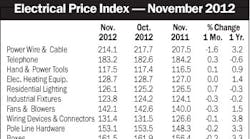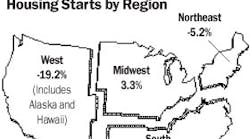Latest from Mag
Latest from Mag
People - Dec 21, 2012
Dec. 21, 2012
Obituaries - Dec 21, 2012
Dec. 21, 2012
November EPI Index Shows No Change
Dec. 21, 2012
Housing Starts Dip 4% in November
Dec. 21, 2012
Electrical Marketing - December 21, 2012
Dec. 21, 2012
Around the Industry - Dec 21, 2012
Dec. 21, 2012
McGraw-Hill Construction, New York, has released its annual Construction Outlook Midyear Update, providing insight into the performance of the construction industry through the end of 2008. Key findings of the forecast, authored by Robert Murray, the company’s vice president of economic affairs, include:
- New construction starts for 2008 are estimated at $558.5 billion, down 11 percent.
- Single-family housing continues to weaken, with 2008 declines of 28 percent in dollar volume and 31 percent in dwelling units, steeper than what occurred in 2007. The single-family market is being adversely affected by falling home prices, mounting inventories and tight lending conditions.
- Commercial building witnessed further expansion in 2006 and 2007, which carried over into the first quarter of 2008. However, the slower economy and tighter lending conditions are now causing projects to be deferred, and the loss of momentum will take firmer hold as the year proceeds. For 2008, commercial building will retreat 8 percent in dollar volume and 16 percent in square feet. Stores and warehouses are the most vulnerable to decline in the near term, while lesser reductions are anticipated for hotels and office buildings.
- Institutional building in 2008 continues to see a strong amount of educational structures reach groundbreaking, helped in particular by more expansion for colleges and universities. The 2008 forecast for institutional building calls for a 2 percent gain in dollar volume, although square footage will settle back 3 percent.
- Public works construction in 2008 will also rise 2 percent in dollars. The push will come from more federal funding for transportation projects in fiscal 2008 and a larger focus on infrastructure repair and maintenance. Increased fiscal concerns by federal and state governments are a bigger factor for this sector, but any drop in construction is more likely to happen in 2009.

